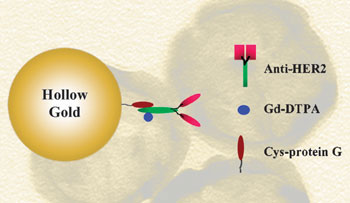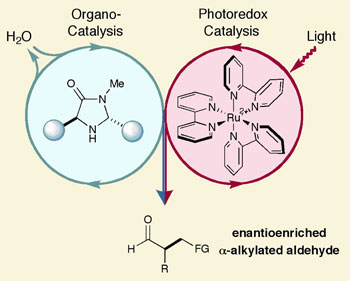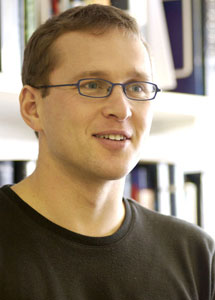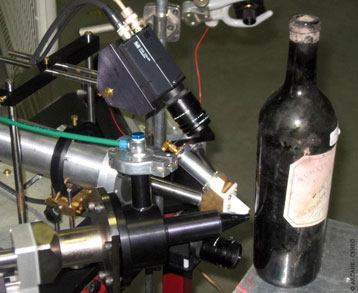Mehr Solarenergieforschung in Deutschland durch Spitzencluster Solarvalley
Das 'Solarvalley Mitteldeutschland' wurde vom Bundesforschungsministerium als ein Spitzencluster ausgewaehlt.
Sep 5th, 2008
Read more
Das 'Solarvalley Mitteldeutschland' wurde vom Bundesforschungsministerium als ein Spitzencluster ausgewaehlt.
Sep 5th, 2008
Read moreSix scientific articles by researchers in the Center for Nanoscale Science and Engineering (CNSE) and Department of Coatings and Polymeric Materials at North Dakota State University (NDSU), Fargo, appear among the most cited articles published in Volume 23 of Biofouling: The Journal of Bioadhesion and Biofilm.
Sep 4th, 2008
Read moreScientists at the U.S. Department of Energy's (DOE) Argonne National Laboratory have won an $800,000 EUREKA award from the National Institutes of Health (NIH) to develop MADMAX, a precise molecular ruler for measuring distances within a protein.
Sep 4th, 2008
Read more Cancer cells can be detected then destroyed using a nanostructure designed by South Korean researchers.
Cancer cells can be detected then destroyed using a nanostructure designed by South Korean researchers.
Sep 4th, 2008
Read more US researchers have cracked a long standing problem in chemical synthesis - the catalytic alpha-alkylation of aldehydes - by combining two catalysts in one pot.
US researchers have cracked a long standing problem in chemical synthesis - the catalytic alpha-alkylation of aldehydes - by combining two catalysts in one pot.
Sep 4th, 2008
Read moreHow does one predict and direct something that is by nature unpredictable and, by necessity, often undirected? According to David Guston, who is co-director of ASU?s Consortium for Science, Policy and Outcomes and a professor of political science, it is by strengthening society?s ability to nurture and guide innovation within socially acceptable frameworks.
Sep 4th, 2008
Read moreScientists peel away the mystery behind gold's catalytic prowess.
Sep 4th, 2008
Read moreA drug delivery system the size of a millionth of a centimeter could hold the key to more effective treatments of cancerous tumors. San Antonio researchers at the University of Texas Health Science Center and homegrown biotech firm Azaya Therapeutics Inc. have teamed up to test the new technology in humans and to bring it to the market.
Sep 4th, 2008
Read moreOn September 8, FDA is holding a public meeting to gather comments and data to assist the agency in the development of agency guidance that would clarify what information industry needs to provide FDA about nanoproducts, and also when the use of nanoscale materials may change the regulatory status of products..
Sep 4th, 2008
Read moreThe devices will be designed to adapt to physical changes in a patient's body and dissolve once they have healed, reducing the follow-up surgeries and potential complications of major orthopedic, craniofacial, and cardiovascular procedures and sparing millions of patients worldwide added pain and medical expenses.
Sep 4th, 2008
Read moreWhy is it that the origins of many serious diseases remain a mystery? In considering that question, a scientist at the University of California, San Diego School of Medicine has come up with a unified molecular view of the indivisible unit of life, the cell, which may provide an answer.
Sep 4th, 2008
Read moreThe project CDuR32 (Critical Dimensions and Registration for 32nm Mask Lithography) is funded in part by the German Federal Ministry of Education and Research. Of the total budget of ?16.7 million (about $24.3 million), the government contributes ?7.9.
Sep 4th, 2008
Read more New ECS Professor Darren Bagnall manages an energetic research group within the Nano Group that is investigating new types of solar cell based on nanotechnology.
New ECS Professor Darren Bagnall manages an energetic research group within the Nano Group that is investigating new types of solar cell based on nanotechnology.
Sep 4th, 2008
Read moreWie sicher ist Nano? Der Antwort wollen Wissenschaftler aus 29 Laendern beim Kongress Nanotox2008 vom 7. bis 10. September an der ETH Zuerich naeher kommen, der bislang groessten internationalen Tagung von Nanotoxikologen.
Sep 4th, 2008
Read more Just like works of art, wine is now being subjected to advanced testing to establish its authenticity: after measuring caesium 137 radioactivity levels to test the age of the wine, the glass in vintage wine bottles is now being tested by particle acceleration.
Just like works of art, wine is now being subjected to advanced testing to establish its authenticity: after measuring caesium 137 radioactivity levels to test the age of the wine, the glass in vintage wine bottles is now being tested by particle acceleration.
Sep 4th, 2008
Read moreThe NAD (Nanoparticles for therapy and diagnosis of Alzheimer's disease) Project is based on the use of nanoparticles for Alzheimer's diagnosis and therapy. The research, costing 14.6 million euros over 5 years, is financed by the European Union's 7th Framework Program and includes 19 European research centers.
Sep 4th, 2008
Read more